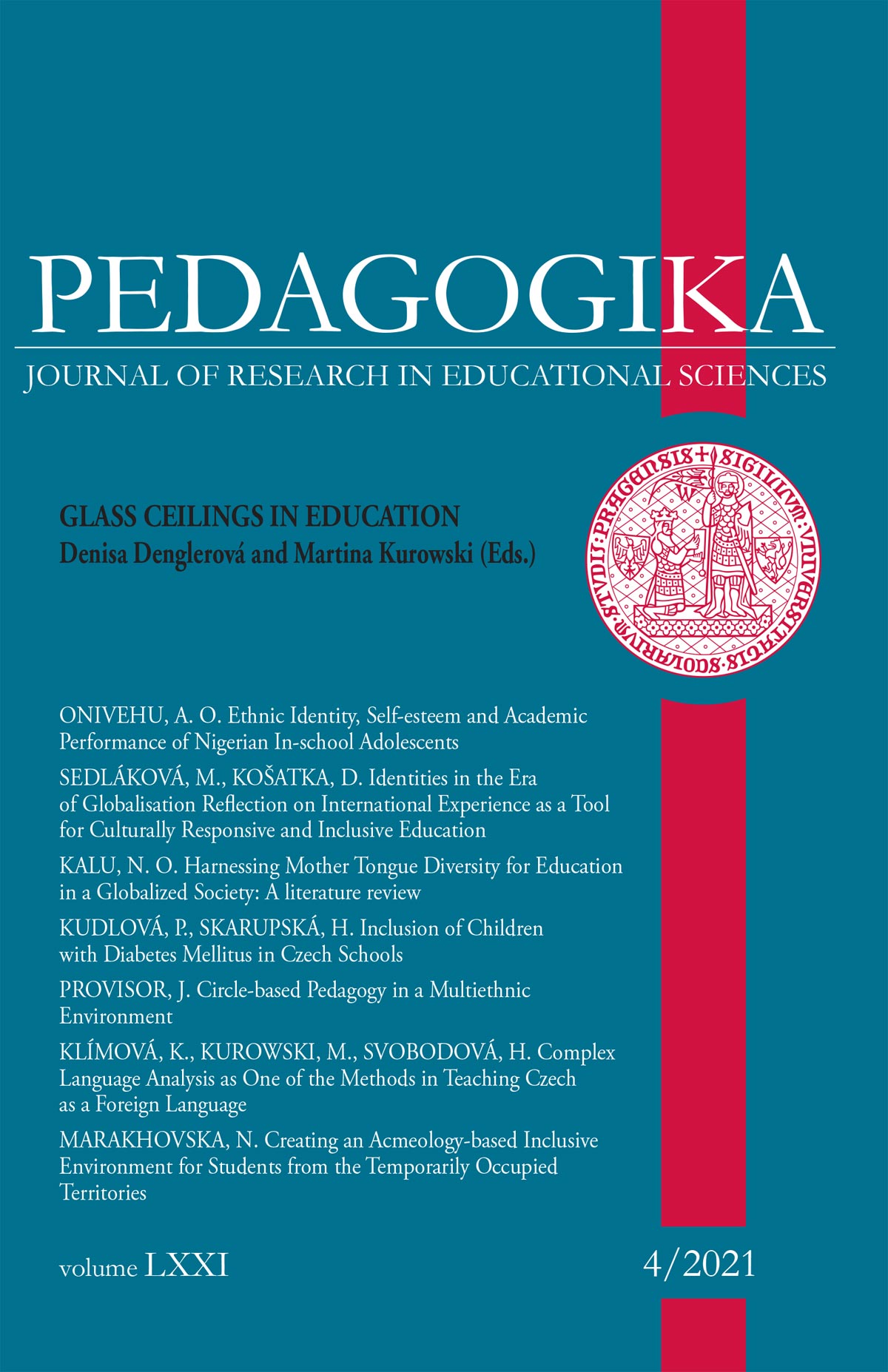Harnessing Mother Tongue Diversity for Education in a Globalized Society: A Literature Review
DOI:
https://doi.org/10.14712/23362189.2021.1968Keywords:
mother tongue, diversity, language awareness and educationAbstract
Diverse cultures and languages traverse borders, including the global educational space, hence the need to create cultural and mother tongue awareness. This paper adopts a theoretical research design, in its review of some articles to discuss the best ways mother tongue diversities can be harnessed in our schools to create a universal system of education that reduces educational inequities and leads to economic growth and cohesion. This review appraises the challenges associated with harnessing mother tongue diversities, and also discusses the benefits of harnessing mother tongue diversities for the students as a preferred solution for maintaining a culturally inclusive learning environment that allows students to flourish in the educational environment by putting their mother tongue into use.
References
Asfaha, Y. M. (2020). Multilingual language policy discourses and superdiversity at the peripheries: Exploring language policy and practice in Eritrea. Journal of Multicultural Discourses, 15(4), 404-421.
https://doi.org/10.1080/17447143.2020.1771346
Bilgin, S. S. (2017). Language awareness: Are pre-service English teachers aware of "language awareness" and its implications? International Journal of Language and Linguistics, 4(3), 65-70.
Cantone, K. F. (2020). Immigrant minority language maintenance in Europe: Focusing on language education policy on teacher-training. International Multilingual Research Journal, 14(2), 100-113.
https://doi.org/10.1080/19313152.2020.1715541
Carrió-Pastor, M. L., & Vallés, I. T. (2015). A comparative study of the influence of the mother tongue in LSP and CLIL. Procedia - Social and Behavioral Sciences, 178, 38-42.
https://doi.org/10.1016/j.sbspro.2015.03.143
Dotzel, S., Bonefeld, M., & Karst, K. (2021). The impact of linguistic diversity on students' reading comprehension using different diversity measures and its' differential effects depending on students' migration background. International Journal of Educational Research, 109 (101796).
https://doi.org/10.1016/j.ijer.2021.101796
Edgar, R. E. (2017). Mother tongue based multilingual education challenges: A case study. Edelweiss Applied Science and Technology, 1, 10-23.
https://doi.org/10.33805/2576.8484.103
European Union (2020). Promoting cultural cohesion through language learning in Austria, Czechia. Available at https://ec.europa.eu/regional_policy/en/projects/Austria/promoting-cultural-cohesion-through-language-learning-in-austria-czechia.
Eurydice - European Commission. (2021). National Reforms in School Education. Available at https://eacea.ec.europa.eu/national-policies/eurydice/content/national-reforms-school-education-17_en.
Fowers, B. J., & Richardson, F. C. (1996). Why is multiculturalism good? American Psychologist, 51(6), 609-621.
https://doi.org/10.1037/0003-066X.51.6.609
Hartmann, D., & Gerteis, J. (2005). Dealing with diversity: Mapping multiculturalism in sociological terms. Sociological Theory, 23(2), 218-240.
https://doi.org/10.1111/j.0735-2751.2005.00251.x
Herzog-Punzenberger, B., Le Pichon-Vorstman, E., & Siarova, H. (2017) Multilingual education in the light of diversity: lessons learned. NESET II report. Luxembourg: Publications Office of the European Union.
Kirsch, C., Aleksić, G., Mortini, S., & Andersen, K. (2020). Developing multilingual practices in early childhood education through professional development in Luxembourg. International Multilingual Research Journal, 14(4), 319-337.
https://doi.org/10.1080/19313152.2020.1730023
Leite, S. (2021). Using the SDGs for global citizenship education: Definitions, challenges, and opportunities. Globalisation, Societies and Education.
https://doi.org/10.1080/14767724.2021.1882957
Lim, L., Tan, M. & Saito, E. (2019). Culturally relevant pedagogy: Developing principles of description and analysis. Teaching and Teacher Education, 77, 43-52.
https://doi.org/10.1016/j.tate.2018.09.011
Mägi, E., & Nestor, N. (2013). Students with different mother tongue and cultural backgrounds in Estonian schools: Attention, awareness and support at school level. Tallinn: Poliitikauuringute Keskus Praxis [Center for Policy Studies].
Martin, S., Minsong, K., & Larry, L. (2019). Affordances and constraints of communities of practice to promote bilingual schooling. Journal of Professional Capital and Community, 4(2), 82-106.
https://doi.org/10.1108/JPCC-01-2018-0003
Mizza, D. (2014). The first language (L1) or mother tongue model vs. the second language (L2) model of literacy instruction. Journal of Education and Human Development, 3(3), 101-109.
https://doi.org/10.15640/jehd.v3n3a8
Ndiribe, M. O., & Aboh, S. C. (2020). Multilingualism and marginalisation: A Nigeria diversity approach. International Journal of Multilingualism.
https://doi.org/10.1080/14790718.2020.1818752
Nishanthi, R. (2020). Understanding of the importance of mother tongue learning. International Journal of Trend in Scientific Research and Development, 5(1), 77-80.
Raz, J. (1998). Multiculturalism. Ratio Juris, 11(3), 193-205.
https://doi.org/10.1111/1467-9337.00086
Rizova, E., Bekar, M., & Velkovski, Z. (2020). Educational challenges of Roma minorities: The case of the Republic of North Macedonia. International Journal of Cognitive Research in Science, Engineering and Education (IJCRSEE), 8(3), 113-122.
https://doi.org/10.23947/2334-8496-2020-8-3-113-122
Scanlan, M., Kim, M., & Ludlow, L. (2019). Affordances and constraints of communities of practice to promote bilingual schooling. Journal of Professional Capital and Community, 4(2), 82-106.
https://doi.org/10.1108/JPCC-01-2018-0003
Tove, S. (2002). Why should linguistic diversity be maintained and supported in Europe? Some arguments. Guide for the development of language education policies in Europe from linguistic diversity to plurilingual education. Strasbourg: DGIV Council of Europe.
Tsai, I. I. (2019). The effect of peer collaboration-based learning on enhancing English oral communication proficiency in MICE. Journal of Hospitality, Leisure, Sport & Tourism Education, 24, 38-49.
https://doi.org/10.1016/j.jhlste.2018.10.006
Yamat, H. (2010). Managing linguistic diversity through informal and non-formal education. Procedia Social and Behavioral Sciences, 7(C), 707-713.
https://doi.org/10.1016/j.sbspro.2010.10.096
Zaidi, R. (2020). Dual language books: Enhancing engagement and language awareness. Journal of Literacy Research, 52(3), 269-292.



